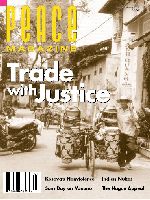
Peace Magazine Jan-Feb 1998, page 28. Some rights reserved.
Search for other articles by Robert Baxter here
The main concern of the author of this valuable book is the use in war of biological weapons, either living organisms or toxins However, he also has a good deal to say about chemical weapons because the two types of agents have much in common.
The use of poisons as weapons has traditionally been found repugnant and condemned as cruel, dishonorable, and unsoldierly. The idea of the use of bacteriological weapons arouses even greater revulsion, perhaps because the science of bacteriology has traditionally been associated with the saving of life. To some, bacteriological warfare seems even more horrifying than the vastly more destructive use of nuclear weapons.
Chemical agents were introduced into modern war in 1915 when the Germans released chlorine against opposing troops on the western front, and by the end of the war virtually all belligerents were using a wide variety;
of chemical weapons on a large scale. They have never since been used on such a scale, partly perhaps from moral revulsion and partly certainly because of the inevitability of massive retaliation in kind. On the occasions when they have been used it has usually been against troops who have been in no position to retaliate. Most recently they have been used by Iraq against the Iranians and against Iraqi Kurds. At that time the apathy of western nations lay with Iraq and the absence of any significant international protest conferred a certain legitimacy on the use of these weapons. Consequently not long afterward the possibility; that they would be used in the Persian Gulf War was a source of considerable anxiety both to the armed forces of the coalition and to the civilian population of Israel.
The only authenticated case of the use of biological agents in modern warfare was by the Japanese against China in the 1930s. However there was considerable concern about the possible use of these weapons too during the Persian Gulf War.
A frightening feature of chemical and biological weapons is that they can be made cheaply and easily by anyone with a moderate degree of scientific knowledge. This makes them tempting to poor countries which cannot afford nuclear weapons but can compete on equal terms with the richest nations in terms of chemical and biological weapons. They are even available to terrorist groups such as the Aum Shinrikyo sect which released a nerve gas in the Tokyo subway in 1995, causing several deaths.
A particular characteristic of biological weapons is that it may not be possible immediately to distinguish an attack from a natural epidemic, to identify the particular agent involved, and to adopt appropriate countermeasures. The author discusses these problems at some length. He also discusses the value of treaties such as the Chemical Weapons Convention (CWC) and the Biological Weapons Convention (BWC) and the difficulties associated with them. These include problems of inspection and verification and of deciding whether any given research project is purely defensive in purpose or if it also has implications for offense. The CWC had not come into force at the time the book was written but it has now, and we may, hope that as the author predicts this will lead to strengthening of the BWC which has been in force since 1975 but lacks verification procedures.
The author recognizes that treaties such as the BWC are essential but he believes that the problem is ultimately a moral one. He concludes that "The avoidance (of biological warfare) is a statement of human decency, an act of will born of high principle."
We must not abandon hope, hut it has to be said that if truth is the first casualty of war, human decency and high moral principle do not long outlive it.

Peace Magazine Jan-Feb 1998, page 28. Some rights reserved.
Search for other articles by Robert Baxter here